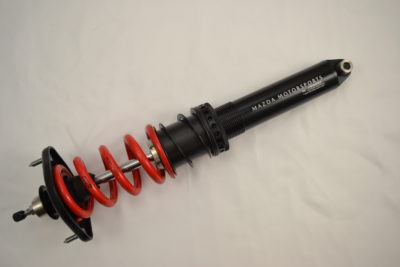Based on recent questions posed by our racers about shock usage, (preventative) maintenance, factors for degradation or damage, Mazda collaborated with industry-leading race shock manufacturer – Penske Racing Shocks.
Below are six important considerations for racers and teams in order to better ensure you get the most quality out of your shocks’ life.
· Towing to and from the racetrack – have a set of tow shocks?
o It is highly recommended to have a set of tow shocks. ALL professional race teams have tow shocks. You will put more wear and tear on all your shock parts towing to and from an event compared to what you will see on a racetrack, generally.
o If this is not possible, we recommend installing travel limiters or secure your vehicle so oscillations in the suspension is reduced during travel to and from the track.
· Adjusting ride height track to track?
o Ride height is a major contributing factor, which is track dependent. For example, Daytona & Sebring would not utilize the same ride height. To maximize shock life, one should adjust ride height according to track requirements to prevent bottoming out.
· Had an “off-track” excursion?
o At minimum, have your shocks dyno’d and rebase lined
o Rebuild, if necessary
§ Large displacements combined with high velocity can over deflect your shims causing loss of damping. Deflective shims are made of materials that when over stressed will lose rate resulting in loss of stiffness.
· Excessive temperature swing?
o When the shock experiences any type of extreme temperature swing, it may negatively affect it. Examples: If you live in the North and in December the car is kept in freezing temps and you plan to travel to FL in January, extreme temperatures can cause excessive leaking which could result in low oil level. On the flip side, if you happen to encounter any type of fire or extreme high temps, usually from the braking system, it’s recommended to have your shocks at least dyno’d to verify performance. Any encounter with fire, we recommend complete rebuild.
· Weeping vs. Leaking?
o We get a lot of questions or concerns of leaking shocks, when in fact the shocks are just weeping. Racing shocks are designed to have minimum friction in the system. This means as the shock is running, it is normal to have weeping oil from between the shock shaft and guide. You may also see a little bit of residual fluid from between the body and the shaft guide. This is normal, if you see what appears to be puddling of shock oil, then we recommend having your shock looked at and possibly the seals replaced.
· Shock extends slowly or not fully?
o If you notice your shock shaft is extending slowly or not fully extending on its own, there are a few things to check.
§ Oil Level: If you have lost too much oil, this will result in the shock not fully extending on its own or doing so slowly.
§ If the shaft stops extending and you can physically pull the shaft out additional length, this means you’re low on oil and service is recommended.
§ If the shaft is just slow to extend, this can be low gas pressure or low oil. The shock is designed to work with a certain amount of oil and nitrogen volume; when either is low, it will affect the rate at which the shock extends under its own pressure. You will not necessarily notice a performance decline unless the pressure is so low that it could cause cavitation in the shock under high velocity operation.
· Low gas pressure: You could be 15-30 psi low on gas, which could be a result from a leak in the system, not proper inflation from service or new. It is recommended that you speak with your service provider or manufacturer and have them supply the dyno graph and gas force result from the time of dyno. Typically, 50 psi of gas pressure may feel like 3-5lb of spring rate to a driver, sometimes less. As mentioned above, the biggest risk in having low gas pressure is cavitation, this happens at higher velocities generally depending on how low the gas pressure is.
